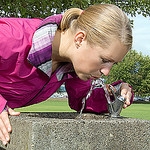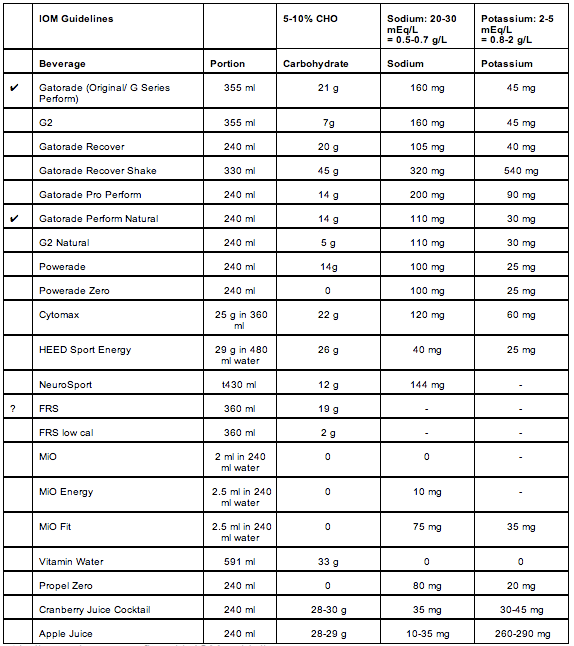Staying Hydrated during Exercise
Posted by Janine Wong MS, RD on February 18, 2013

Part 3 of a 3 part hydration series
The Starting Line:
What is the best way to stay hydrated during exercise?
Staying hydrated during exercise is important for physiological safety and for performance. Once you’ve assessed your individual fluid needs, the next step is to develop your hydration plan.
Before Exercise:
Ideally, when starting an exercise session, you should be in a state of normal hydration, also known as euhydrated. According to ACSM (American College of Sports Medicine), this can be accomplished with normal beverage consumption throughout the day, provided that your last exercise session was 8-12 hours ago. In the case that a pre-hydration regimen is needed, ACSM recommends starting early, with 5-7 ml of water per kg body weight (about 12 to 16 ounces for a 150 pound person) four hours prior to exercising. Trying to rush hydration by gulping down large volumes can actually increase urine output.
During Exercise:
The goal of hydration during exercise is to maintain body weight within 2% of your baseline (Sawka 2007), while avoiding weight gain through excessive fluid consumption (O’Connor 2006 and Rosner 2007). Once you determine your sweat rate, you’ll know how much you need to replace through water or sports beverage consumption. If determining your sweat rate though nude body weights is impractical, Rosner and Kirven suggest drinking according to thirst, and limiting yourself to 400-800 ml per hour of exercise. Similarly, ACSM recommends drinking one half to one liter of sport beverage per hour to meet carbohydrate and fluid needs during long exercise (Sawka 2007).
Use of sports beverages with the combination of fluid, electrolytes, and carbohydrate can help sustain performance for longer events. See the table below for a list of sport beverages that meet the guidelines set by the Institute of Medicine (IOM). It is important to note that most sports beverages do not provide adequate sodium to completely replace losses in sweat. Therefore, using caution for overhydration is a good strategy for preventing hyponatremia.
There are products that claim to promote hyperhydration with water binding agents. These products have failed to provide thermoregulatory or performance benefits. Furthermore, they increase urine output and increase the risk for hyponatremia (Sawka 2012). There are also products marketed as low calorie, like G2 or Powerade Zero, however you can tell from the table below, that these do not meet IOM guidelines for a sport beverage because they do not provide adequate carbohydrates to support performance. Many sports beverages also contain caffeine. Contrary to common belief, caffeine in moderate doses does not affect hydration status.
After Exercise:
If you find yourself dehydrated after exercise, ACSM recommends drinking 1.5 liters for each kilogram of body weight lost. The additional volume over the 1 ml for each gram is to offset the increased urine output from consuming large volumes at once. Rehydration is best done gradually if time permits, and eating salty foods can help with water retention. Alcohol increases urine output and delays rehydration. If you want to enjoy a beer at a post-race beer garden, make sure you rehydrate first.
The Finish Line:
The goal of hydration is to replace lost fluids. Sports beverages are a good option for longer events or hot conditions.

✔indicates beverage fits with IOM guidelines *Nutrition information obtained from product labels and websites. - indicates info not provided, ? indicates not able to assess if product fits IOM guidelines due to lack of nutritional info
References:
1. Kenefick, R.W., Cheuvront, S.N. Hydration for recreational sport and physical activity. Nutrition Reviews. 2012. 70:s137-s142. http://www.ncbi.nlm.nih.gov/pubmed/23121349
2. Rosner, M.H. and Kirven, J. Exercise-Associated Hyponatremia. Clinical Journal of the American Society of Nephrology. 2007. 2:151-161. http://cjasn.asnjournals.org/content/2/1/151.full
3. Sawka, M.N., Burke, L.M., Eichner, R., Maughan, R.J., Montain, S.J., Stachenfeld, N.S., Exercise and Fluid Replacement. Medicine and Science in Sports and Exercise. 2007. 39:337-390. http://www.ncbi.nlm.nih.gov/pubmed/17277604
Photo Credit: lululemon athletica via photopin cc
*Note: This general information is not intended to be a substitute for medical treatment or advice. Always consult a professional before making changes to your health and wellness practices.
Feedback or suggestions for future topics? Let us know!
